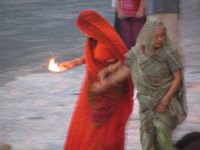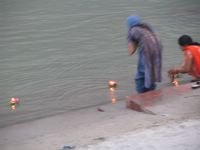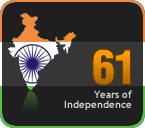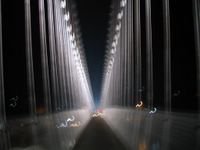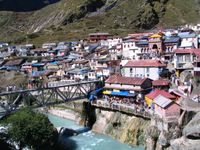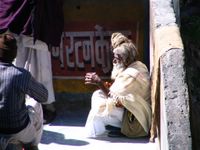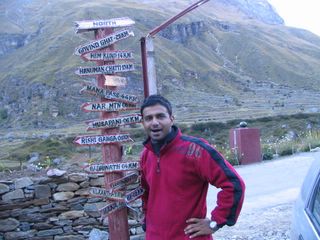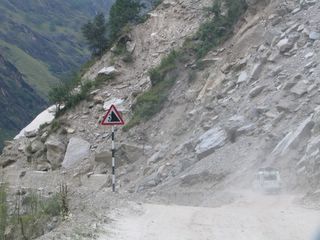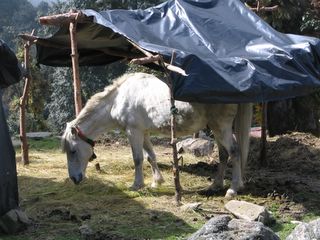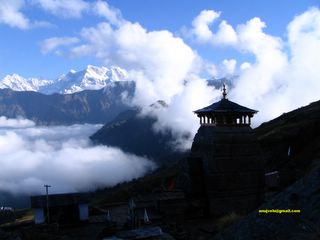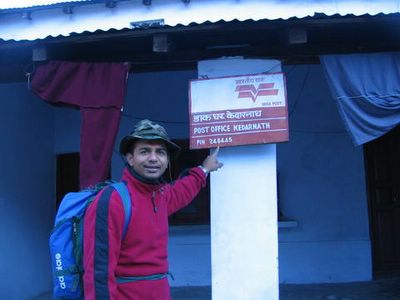Day 2: Rudraprayag to Kedarnath
===============================
From Rudraprayag, the NH 58 continues onto Badrinath, whereas we cut off to the left into NH 119. It takes about two & half hours to make it to Gaurikund. On the way, we had our first sighting of snow clad mountains & very thrilling it is.
The road also rises sharply & has tight turns. A bit of care needed here.
There is a huge parking lot at Gaurikund, which is absolutely empty at this time of the year. If you stayed at Srinagar for the night, you would only reach Gaurikund in the night. As such, a night’s halt there is recommended. The night aarti there is supposed to be nice. Unfortunately I could not see it. We reached Gaurikund early in the morning & went straight across the village where the Army mules were waiting for us.
Road Conditions: I guess NH 119 is a newly declared national highway, because the quality of the road does fall a bit. But still the road condition is fairly good till Guptakashi, where it drops sharply. Horrible at places for an Alto.
Kedarnath Trek :
=================
There are three ways you could make your way to Kedarnath. Walking, on ponies or by “palki”, I am told that the rates for these fluctuate a lot with the seasons. Right now, there are not too many tourists/devotees, so the rates were on the lower side. Ponies were offered for 350 Rs, & palki’s for 2200/- return trip.
I didn’t take either as the Army mules were waiting for us. These creatures are really neat & do the trek in just under 4 hours instead of the 6 that the “civilian” mules take.
The weather those days was absolutely glorious in the early mornings with the clouds rolling in around noon.
Gaurikund – Rambana : A small cluster of Shacks called “Rambana” marks the halfway point of the 14 Km trek. The trail throughout this patch is wide & cemented & mostly low gradient.
Rambana to Kedarnath : From here the gradient steeps out a bit. Till the last few km, where it peters down to a flat road. The point where it flattens down is also called Deo-Dekhni because you can see the roof of the temple from here.
Throughout the trail, you’ll find a lot of small shops selling tea/coffee and things like Alu-puri, maggi etc. So you don’t need to carry anything to eat.
The final point for the ponies is the bridge across the Mandakini.
Kedarnath : If you stand on the bridge, on the hill on your left, you can see the hydel power plant, which generates the power for the village. On the hill on the right, there is the trail that leads to the Bhairavnath Temple.
The village is essentially one street that leads up to the village. On either side of the street are these small shops selling trinkets & prasad & on the far side of the shops & small guesthouses, most of which are empty this time of the year. I found a nice room for us hardly 50 m from the temple for 150/- a day.
It’s a good idea to stay for the day at Kedarnath. The place is simply too beautiful to rush. Plus the evening aarti is awesome.
The aarti begins around 6 PM & unlike the few aarti that I have seen, there is hardly any chanting or singing. Just a lot of drums & bells. There are huge bells that are hung on the temple gates & small bells in the hands of the pandits. There are big drums in the temple courtyards & small “damru’s” in the hands of the sadhu’s. For half the aarti, I sat in the temple hardly seeing anything, just enjoying the atmosphere, but the other half, I came out in the courtyard & it was stunning. All the people were standing mildly chanting privately, while the sadhus were banging away on their drums, damru’s & bells. Out in the open, surrounded by the Himalayas, it was simply ethereal.
I intended to do the Abhishek puja early the next morning, but around eight, they found out that there was a solar eclipse happening on the 3rd. No puja. Bummer. But then it was decided that we could conduct the puja between 1 & 4 am. So we decided to have the puja at 3 AM & went to bed early. A freezing bed that took a long time to thaw.
Mythological Trivia : Kedarnath is one of the “char-dhams” As per legend, the pandavs wanted Shiva to forgive them for killing so many of their family members. But Shiva was not moved & was trying to hide from the Pandavs. But the pandavs finally cornered Shiva in the Himalayas. Shiva then took the form of a buffalo and tried to hide from them in a herd. After failing to catch the buffalo, Bhim finally hit it with his Gadha & this allowed him to finally catch Shiva. But Shiva in a final attempt to evade capture dun under ground & Bhim was only able to catch his rump. His other body parts came out in four different locations & these five locations together are called “panch-Kedar” of five kedars. The Pandav’s then built the temple around the rump & since that day, humans apply ghee to the rump to sooth the wound of the god.
Distance covered : 75 km car + 14km pony

